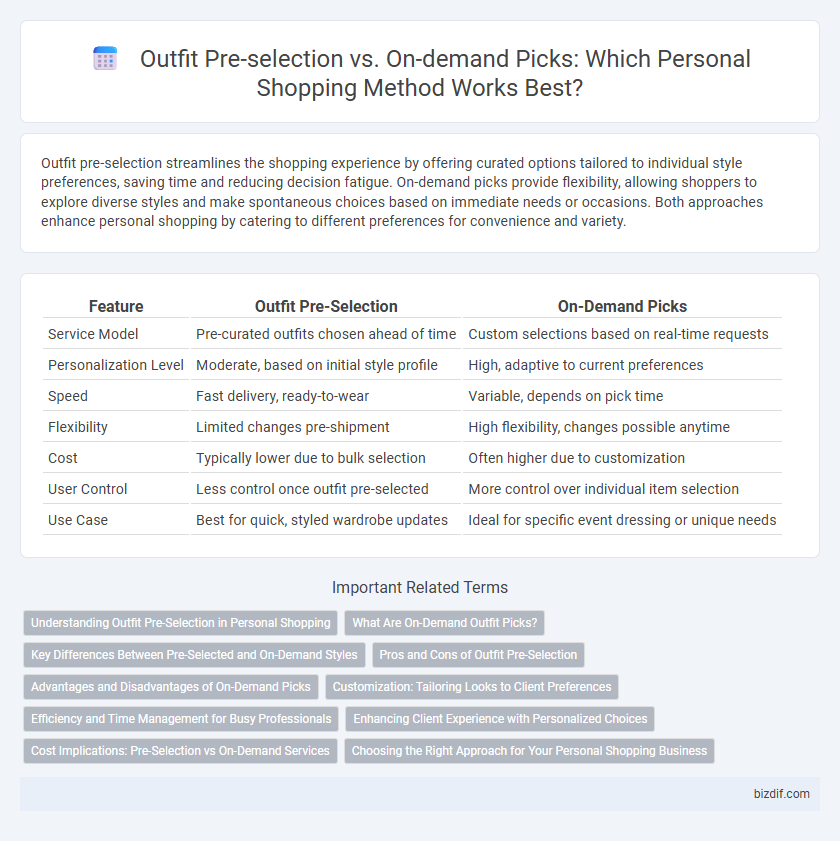Outfit pre-selection streamlines the shopping experience by offering curated options tailored to individual style preferences, saving time and reducing decision fatigue. On-demand picks provide flexibility, allowing shoppers to explore diverse styles and make spontaneous choices based on immediate needs or occasions. Both approaches enhance personal shopping by catering to different preferences for convenience and variety.
Table of Comparison
| Feature | Outfit Pre-Selection | On-Demand Picks |
|---|---|---|
| Service Model | Pre-curated outfits chosen ahead of time | Custom selections based on real-time requests |
| Personalization Level | Moderate, based on initial style profile | High, adaptive to current preferences |
| Speed | Fast delivery, ready-to-wear | Variable, depends on pick time |
| Flexibility | Limited changes pre-shipment | High flexibility, changes possible anytime |
| Cost | Typically lower due to bulk selection | Often higher due to customization |
| User Control | Less control once outfit pre-selected | More control over individual item selection |
| Use Case | Best for quick, styled wardrobe updates | Ideal for specific event dressing or unique needs |
Understanding Outfit Pre-Selection in Personal Shopping
Outfit pre-selection in personal shopping involves curating complete ensembles based on a client's style, preferences, and body type before the shopping session begins, ensuring a cohesive and time-efficient experience. This method reduces decision fatigue by presenting coordinated looks rather than individual items, leveraging style algorithms and stylist expertise to anticipate needs. Compared to on-demand picks, outfit pre-selection delivers a tailored and streamlined wardrobe update, enhancing satisfaction and wardrobe coherence.
What Are On-Demand Outfit Picks?
On-demand outfit picks refer to personalized clothing selections created instantly based on current user preferences, occasions, and trends. Unlike outfit pre-selection, which involves curated looks prepared in advance, on-demand picks leverage real-time data and AI-driven styling algorithms to offer fresh, customized ensembles whenever requested. This approach ensures flexibility, up-to-date fashion relevance, and a highly tailored shopping experience.
Key Differences Between Pre-Selected and On-Demand Styles
Outfit pre-selection offers curated ensembles tailored to a customer's style profile and sizing, providing convenience and a cohesive look without the need for immediate decision-making. On-demand picks allow shoppers to request specific items or styles in real-time, offering flexibility and customization based on current needs or trends. Pre-selected options prioritize efficiency and season-long wardrobes, while on-demand services emphasize personalization and adaptability for spontaneous fashion choices.
Pros and Cons of Outfit Pre-Selection
Outfit pre-selection streamlines the shopping experience by offering curated clothing combinations based on personal style, saving time and reducing decision fatigue. However, it limits spontaneous choices and may not adapt quickly to changing tastes or immediate needs. This approach is ideal for customers seeking consistency and convenience but less suitable for those wanting frequent style updates or highly personalized, on-demand options.
Advantages and Disadvantages of On-Demand Picks
On-demand picks offer personalized styling tailored to real-time preferences, providing flexibility and instant updates on trends, which enhances customer satisfaction and relevance. However, the lack of pre-curation can lead to decision fatigue and longer selection times compared to outfit pre-selection, potentially reducing efficiency. This approach suits consumers seeking spontaneity but may not be ideal for those preferring a streamlined, pre-vetted wardrobe.
Customization: Tailoring Looks to Client Preferences
Outfit pre-selection offers a curated wardrobe aligned with a client's established style profile, ensuring each piece complements their preferences and lifestyle. On-demand picks provide real-time customization, adapting choices based on immediate feedback and evolving client tastes. Both methods enhance personalization by tailoring looks to individual needs, balancing convenience with bespoke style precision.
Efficiency and Time Management for Busy Professionals
Outfit pre-selection streamlines wardrobe choices by curating complete looks ahead of time, eliminating daily decision-making and reducing morning stress. On-demand picks offer flexibility, catering to immediate needs and last-minute events, but may require more frequent time investment. Busy professionals maximize efficiency by leveraging pre-selected outfits for routine days and reserving on-demand services for spontaneous occasions.
Enhancing Client Experience with Personalized Choices
Outfit pre-selection streamlines the shopping process by offering clients curated ensembles tailored to their style preferences and lifestyle needs, reducing decision fatigue and increasing satisfaction. On-demand picks provide real-time customization, allowing for adaptive and responsive selections that reflect immediate client feedback and evolving trends. Combining these methods enhances the personal shopping experience by delivering consistently relevant, personalized choices that anticipate and respond to individual client desires.
Cost Implications: Pre-Selection vs On-Demand Services
Outfit pre-selection services typically offer fixed pricing models that can reduce overall costs through bulk selection and seasonal planning, while on-demand picks often incur higher fees due to personalized, real-time customization and immediate fashion trends. Pre-selection allows for budgeting efficiency by minimizing frequent purchases, whereas on-demand services might lead to increased expenses influenced by urgency and exclusivity of apparel choices. Evaluating cost implications depends on individual shopping habits and preference for convenience versus planned wardrobe investment.
Choosing the Right Approach for Your Personal Shopping Business
Outfit pre-selection streamlines the personal shopping process by offering curated collections tailored to client preferences, enhancing efficiency and client satisfaction. On-demand picks provide flexibility and customization, allowing shoppers to respond to real-time requests and unique style needs, fostering personalized experiences. Selecting the right approach depends on your business model, client demographics, and the balance between scalability and bespoke service.
Outfit pre-selection vs On-demand picks Infographic

 bizdif.com
bizdif.com